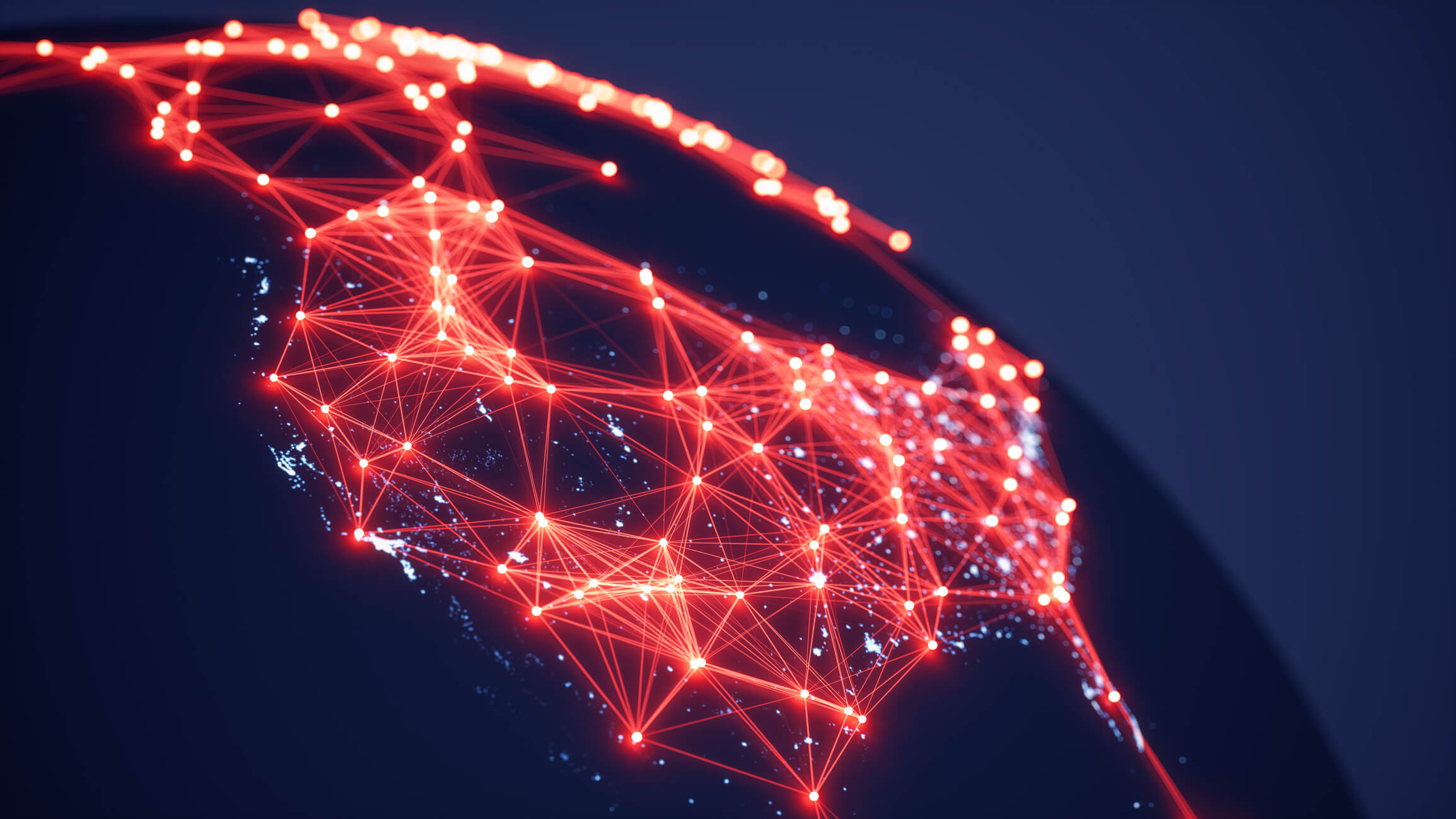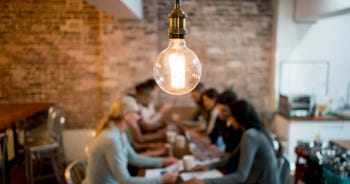A guide to decentralised energy for businesses: An empowering future?
If you’ve never heard of decentralised energy, you might be wondering why it matters to business owners. Well, do you or anyone you know have solar panels installed? As it stands, solar panels are part of a decentralised system, so it’s closer to home than you’d think.
But on a larger scale, the idea of decentralised energy is quite a complex one, so let’s break it down, to discover what it is and how it’s changing energy production globally.

Five point summary
- Decentralised energy involves generating power close to where it's used, often using renewable sources.
- Using a decentralised system over a centralised system can improve a country's energy resilience, lower costs for businesses and homeowners, and reduce emissions.
- Barriers to a fully decentralised system include high initial costs, integration complexities, weather dependence, and regulatory issues.
- All kinds of businesses can benefit from this type of system, but it may benefit those in manufacturing, off-grid businesses, and local communities the most.
- Grants and environmental tax incentives can support decentralised energy adoption and many countries are considering a fully decentralised system to help reach sustainability targets.
What is decentralised energy?
Decentralised energy - also known as distributed energy - is power that is generated close to where it will be used rather than coming in from a large power plant. This type of generation is often done on a small scale and, more often than not, includes renewable energy systems.
Solar, wind power, small hydro, biomass, and even combined heat and power (CHP) are renewable energy sources commonly used to generate decentralised energy.
What is a decentralised energy system?
A decentralised energy system refers to a network of renewable energy sources close to the point of energy consumption. The network produces decentralised energy, unlike centralised power generated from large power plants, which travels a long distance to the point of consumption.
Using decentralised energy often leads to better energy security because you’re not vulnerable to failures from The National Grid, as it’s not solely relying on it. It also produces fewer emissions if renewable, low-carbon energy sources are used, making it great for businesses that want to generate their own power to lower their carbon footprint.
Does the UK have a decentralised energy system?
As it currently stands, in the UK, we have a hybrid system with long-standing centralised elements.
But historically, the UK has been centralised, with all homes and businesses linked up to large power plants that generate and send power across the country. Small-scale renewable energy systems are increasing as we work as a nation to hit our net zero target.
The latest Energy Trends Report reveals that: "Production from renewable technologies in 2024 increased 7 per cent to a record 144.7 TWh, and a record share of 50.8% of electricity generation, passing half of generation for the first time."
These systems allow those using them to generate and consume their own energy and sell the excess back to the grid through schemes like the Smart Export Guarantee. As these types of systems increase, our centralised system becomes fragmented, and we move towards a more decentralised energy system. As greener electricity grows, more local grids (or mini-grids) are needed to support our infrastructure and ensure it can stand the test of time.
What countries are using a decentralised energy network?
Many European countries have set ambitious sustainability targets nationally as they work towards net zero. Although decentralised systems are complicated to get right, they are needed if we want a 100% green future globally.
Some countries that are already incorporating these include:
UK
The UK is moving towards a more decentralised energy system. It has historically relied on centralised power plants, but smaller, localised energy sources are becoming more common. This trend is driven by factors like the need to reduce carbon emissions, improve energy security, and increase community control over energy production.
Here are some ways the UK is using decentralised energy:
- Local generation through renewables - A growing number of homes, businesses, and communities in the UK generate electricity using solar panels, wind turbines, biomass boilers, and micro-hydro systems. These systems are installed close to the point of use, reducing transmission losses and easing pressure on the national grid.
- Community energy projects - Local groups and cooperatives are developing community-owned energy schemes. These often involve solar farms or wind turbines where the electricity is used by nearby homes and businesses. Profits are usually reinvested into the community or used to reduce local energy bills.
- Combined Heat and Power (CHP) and district heating - CHP systems and district heat networks are being deployed in urban areas to deliver heat and electricity from a single source to multiple buildings, such as residential blocks, hospitals, or campuses, improving efficiency and reducing emissions.
- Smart grids and battery storage - Decentralised energy is supported by smart grid technology and battery storage. These systems allow users to store surplus renewable energy and feed it back into the grid when demand is high. This helps balance supply and demand locally.
- Microgrids and local energy markets - Some regions and business parks are developing microgrids. These small-scale networks can operate independently or alongside the main grid. These often include peer-to-peer energy trading, where businesses or households buy and sell electricity locally, often enabled by blockchain technology or energy platforms.
- Government support and regulation - Schemes like the Smart Export Guarantee (SEG) and Contracts for Difference (CfD) support decentralised generation by guaranteeing payments for excess energy exported to the grid. Regulatory frameworks are also evolving to make decentralised energy more accessible and viable. For more information, check out our guide to how business energy is bought and sold.
Germany
Germany has made the transition to a decentralised energy system, with renewables at the heart of it. Their main aim is to avoid greenhouse gasses, increase energy efficiency and become carbon neutral.
How are they doing it?
- They phased out nuclear energy in 2022 (as it’s non-renewable)
- Phasing out coal production by 2038
- Increase energy efficiency to produce more output
- Increase share of renewables by 80% by 2050
- Expand networks and storage capabilities
But what does this mean in practice? Large power plants that are connected to a main network are being replaced by lots of smaller generation plants linked through smaller networks. More and more homeowners and businesses are generating their own power through renewable systems, and battery storage is increasing.
Germany has also been exploring ways to increase low-carbon energy generation by getting its citizens involved. This includes more decentralised systems in cities and as part of community projects.
The city of Frankfurt has committed to changing its entire energy supply to renewable by 2050 by reducing consumption and reducing C02 emissions by 95%.
That’s an ambitious target. To make this happen, German councils, energy suppliers, residents, and housing companies will have to work together to create a decentralisation system with local grids to power up the city.
Denmark
In 2012, the Danish parliament voted for the country to become 100% renewable by 2050. To achieve this, the government is reducing energy consumption and increasing decentralised energy generation and renewable energy sources.
As part of its largely decentralised system, the country has widespread use of wind turbines and community-owned wind farms. This is where a local community funds the renewable energy system and uses its power on a local level.
District heating systems are also popular - this is a heating system for a local area or (a centralised location) where the energy produced is distributed to local residences and businesses in the area.
USA
Most of the electricity that Americans use is from centralised generation, but some states, such as New York and California, are at the forefront of adopting decentralisation, leaving the USA with a mix of both centralised and decentralised systems.
The National Renewable Energy Laboratory (NREL) is researching new ways to ensure a low-carbon future. Its answer is “Autonomous Energy Grids" (AEGs). These are self-organised grids at the edge of the main grid and cooperate on a local and regional level. They’re interconnected to the larger grid, but they would be self-reliant, meaning they could still operate if there was a failure with the main grid. This would provide a solution to isolated areas across states and provide more grid resilience as the country expands its use of different renewable energy systems.
Are decentralised energy systems scalable for businesses of all sizes?
In practice, yes, but in reality, this depends on many factors, such as the size and energy needs of a business as well as resources and investment.
For example, a small gift shop is likely to use less energy than a local cafe, so a small system with solar panels would be a good option. On the other hand, a restaurant may need more than a few solar panels to cope with the energy demands of appliances like fridges, ovens and gas for cooking on stoves.
If the UK continues to become more decentralised, we’ll see a lot more ‘mini-grids’ appearing, serving local areas. These are linked up as part of a larger distribution network, which can connected to the main grid.
If we eventually link up all the mini-grids with new technology, we can create a stronger, more reliable system for the whole country that may better withstand natural disasters, bad weather or even cyber-attacks.
What are the benefits of using decentralised energy?
- Energy resilience - Using a decentralised energy system provides better resilience to grid failures and natural disasters that may affect a larger grid. Having a self-generated supply provides safety and allows businesses to have control over their energy reliability and usage.
- Lower energy costs - Since decentralised systems consist of individuals creating their own renewable electricity - energy costs are generally lower than energy bills from using the national grid. Although the initial investment for these systems can be hefty, over the long haul, it normally pays off. Read more about renewable energy systems for business here.
- Environmental sustainability- Because decentralised energy systems are mostly made up of renewable energy sources, they produce fewer greenhouse gasses and emissions than traditional energy sources. This leads to a much more low-carbon and sustainable supply of energy.
- Reduced transmission losses - Because decentralised systems are often situated close to where the power is used, there is less chance of energy transmission loss than if it was transported a long distance. This reduces the chance of disruption as well as improving energy efficiency.
Are there any challenges associated with decentralised energy?
- High initial costs - Like any new infrastructure, it’s expensive. Scaling decentralised energy across the whole country means the current system would need an overhaul. This throws up the question of how governments can fund these huge types of projects. Not only that, but SMEs need to invest in their own renewable systems, stumping up an initial investment.
- Complex to integrate - Decentralised systems are complicated to integrate at scale. Professional designers and infrastructure architects are needed for these huge projects. When it comes to installing a renewable energy system, businesses and homeowners lack the expertise to do it and, in some cases, need the help of an energy consultant, which can be costly.
- Mostly weather dependent - Popular renewable energy sources like solar and wind are weather-dependent. If our whole decentralised system is based on unpredictable UK weather, it’s not reliable. To combat this, we need to diversify our energy mix and make use of energy storage systems to store excess energy for rainy days - incurring more investment.
- Regulatory hurdles - because many worldwide energy systems have traditionally been centralised, most government policy and regulatory standards have been built around it. New policies and standards around installation, usage and compliance need to be written, creating delays and hurdles for expanding decentralised systems.
Can decentralised energy systems impact the grid in any way?
In short, yes - a decentralised system impacts the main grid.
Without getting too complicated, decentralised systems lower the demand for conventional fossil fuel energy from the grid. But, as energy demand fluctuates, and in times of high demand, there may not be enough renewable energy resources available. In this case, the grid will draw on fossil-fueled energy to avoid any disruption to power.
As more renewable sources are linked to our national grid system, this can cause problems with forecasting and meeting the ‘load’ or demand. And not everyone who creates self-generated electricity will make enough to cover their daily energy usage, especially for high-consumption businesses. This puts pressure on our grid system to be more flexible and react quickly to changes in supply and demand.
As our UK decentralised system expands, smart grid technologies that use AI to be more energy-efficient should be used to manage integration and demand of energy effectively.
What type of businesses will benefit the most from decentralised energy?
- Businesses in local communities - Because the nature of decentralised systems is to serve up power locally, many communities will benefit. In some cases, they already are. In Islington, London, the Burnhill Heat and Power Network has been set up by Islington Borough Council to supply cheaper, greener heat to over 700 homes and two leisure centres.
- Small to medium businesses - Small businesses like cafes and retail stores with high energy bills might find they can lower costs with a decentralised system. Installing solar panels, biomass systems, or microturbines can improve energy efficiency and help with energy bills in the long run.
- Industrial and manufacturing industries - Businesses that use a lot of energy, like large manufacturers or warehouses, could benefit from generating their own electricity. CHP systems, or hybrid installations, can continually produce both heat and power and reduce reliance on the grid, cutting energy bills.
- Businesses off the grid - Remote businesses, like forest lodges, for example, can generate their own power to provide heat and electricity for guests. This means owners can reduce energy bills and focus on maximising profits.
What are some examples of decentralised energy solutions suitable for businesses?
Here are some key examples of decentralized energy solutions that are well-suited to businesses:
- Solar panels (solar PV) - One of the most common options. Businesses can install solar panels on rooftops or adjacent land to generate electricity on-site and reduce reliance on the grid.
- Wind turbines - Ideal for businesses in rural or windy areas. Small and medium-sized turbines can supply power to a single site or building.
- Combined Heat and Power (CHP) - Generates electricity and captures waste heat for heating. CHP units are particularly effective for energy-intensive businesses like hotels, hospitals, and factories.
- Biomass boilers - Use organic materials like wood chips or pellets to generate heat and hot water. They’re suitable for businesses with high heating demands or access to waste biomass.
- Battery storage systems - Paired with renewable systems, batteries store excess electricity for later use to help businesses avoid peak energy rates and power outages.
- Ground or air source heat pumps - Extract heat from the ground or air to provide heating and hot water. Heat pumps can be a good option for businesses with consistent temperature control needs.
- Micro-hydro power - If your business is near a river or stream, micro-hydro systems can provide a constant, reliable electricity source by harnessing flowing water.
- Peer-to-peer energy trading systems - Some businesses in energy-sharing networks can buy or sell electricity directly to/from nearby users, supporting local grids and renewable use.
Get your business set with Bionic
If you’re planning to go down the route of self-generated electricity, then It's worth researching all available grants on your local government site and reviewing environmental taxes for green energy production.
And if you’re not in a position to install a renewable energy system at the moment, at Bionic, our tech-enabled experts will help you to compare business energy quotes from our trusted panel of suppliers, including business electricity and business gas deals. And because business energy is more complex than domestic, we'll talk you through the results to ensure you get the right package for your business.
Interested in more content on business energy? Head to our energy guide pages for more information.








